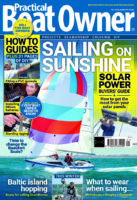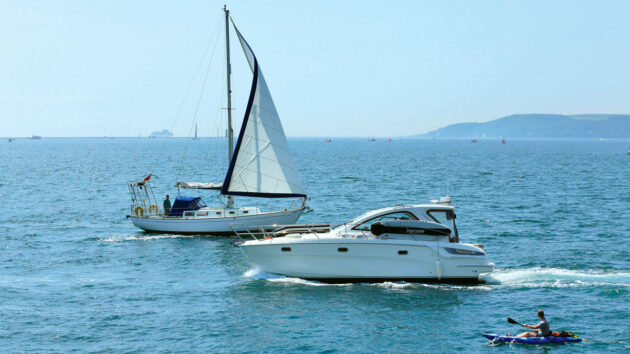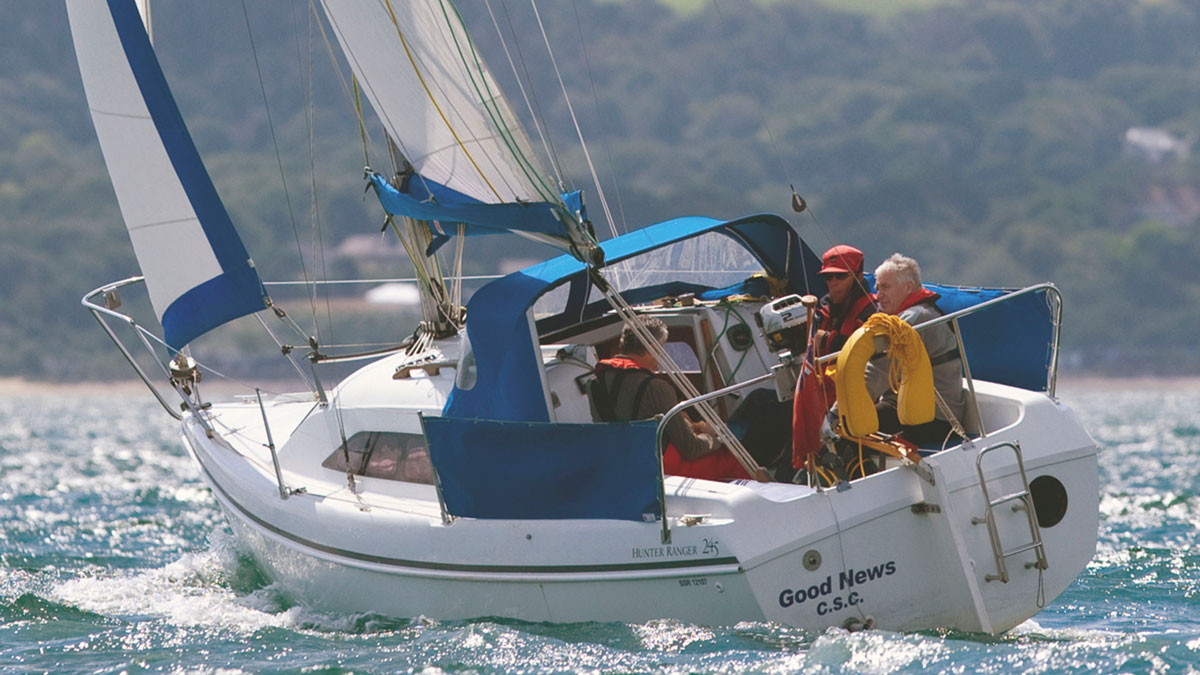If you’re at the helm, can you spot a risk of collision with another boat? Do you know when to ‘stand on’ and when to ‘give way’?
Taking over at the helm, even as a temporary stand-in while the skipper nips below, means you must be conversant with the International Regulations for Preventing Collisions at Sea (COLREGS).
More than just a matter of common sense, these regulations lay down precise guidelines on how not to get involved in a maritime accident.
The full collision regulations are quite long and very specific, running to 41 rules, each of them further subdivided into sections.
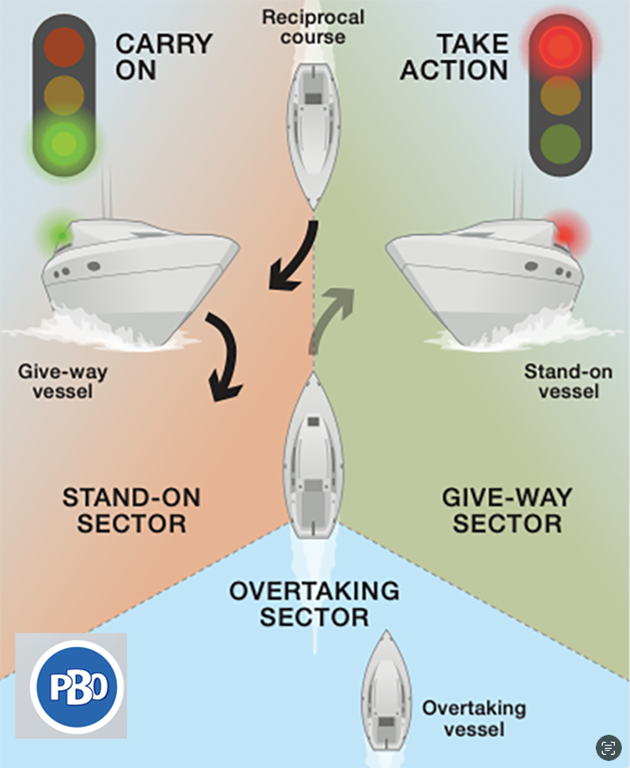
The collision regulations say that a boat approaching from starboard should ‘stand on’, and one approaching from port should ‘give way’. An overtaking vessel also has a responsibility to keep clear. Credit: Practical Boat Owner
But the gist of them is quite easy to appreciate.
Basically, it is a powered boat’s responsibility to keep clear of any large commercial vessel, of any sailing boat which is actually sailing, or of any fishing boat which is actually engaged in fishing.
Further to this, there are rules as to how two power-driven craft should ensure they steer clear of each other.
Avoiding boat collisions: Overtaking
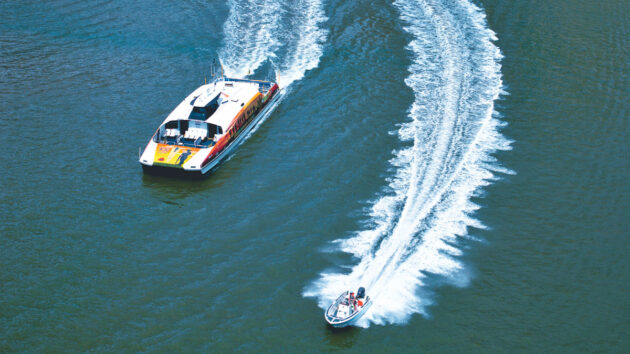
In rivers and channels, you should overtake on the slower vessel’s port side. Credit: Colin Underhill/Alamy
When one powered boat is overtaking another, it is the overtaking vessel’s responsibility to keep clear.
In open water, it does not really matter which side you pass the slower vessel on, but in channels and rivers you should overtake along its port side.
Before making the overtaking manoeuvre, ensure there is plenty of space to get past and that you are not going to compromise any other vessels coming towards you.
Avoiding boat collisions: Head-to-head
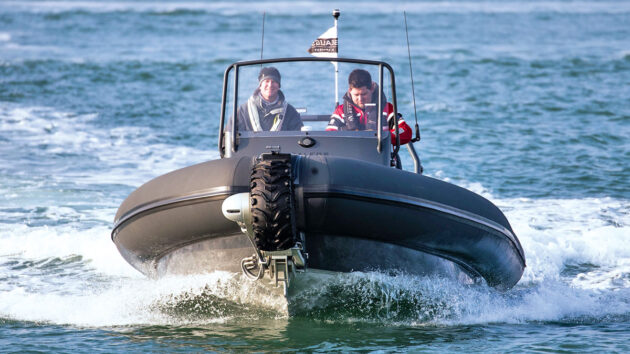
When two power-driven craft approach head-on, both should alter course to starboard, so they pass each other port-to-port. Credit: Richard Langdon
When two power-driven craft are meeting head-on, or nearly head-on, both should alter course to starboard, and hence pass each other port-to-port.
The important thing here is to make any alteration large enough (and early enough) that it is readily apparent to the other vessel what you are doing.
Avoid the tendency to nudge the helm over just a few degrees; let other vessel’s crew clearly see your port flank.
Avoiding boat collisions: Standing on and giving way
Where another powered boat is converging on you from your port side, it is that boat’s responsibility to give way to avoid a collision with you, usually by altering course and speed to pass behind you.
Yours is known as the ‘stand on’ vessel.
The corollary of this is that where another motorboat is converging on you from the starboard side, it is your responsibility to stay clear of it.
In this case, you are the ‘give-way’ vessel. A good way to learn this is to think of it like a roundabout on the roads. You give way to traffic coming from your right. Best practice for a ‘give-way’ vessel is to alter your course and speed to drop behind the other boat, rather than try to press on and pass in front of it.
Am I on a collision course?
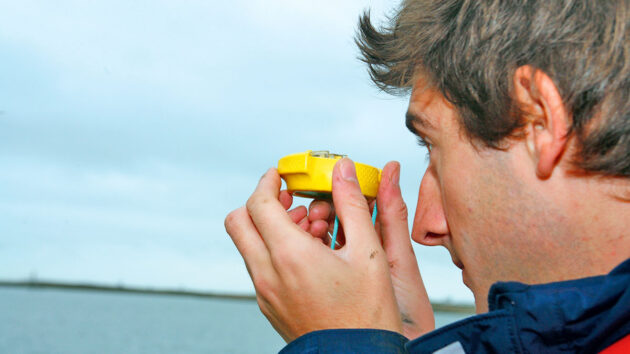
Check a boat’s bearing using a hand-bearing compass. If the bearing of another vessel remains constant, you are on a collision course. Credit: William Payne/Future
To assess whether you are likely to be in danger of colliding with another boat, you should check its bearing by using a hand bearing compass or (if it can be aligned with the target), the helm’s steering compass.
If the bearing remains pretty constant over a period of time, then both vessels are on converging courses, and action needs to be taken.
If the bearing between the vessels is decreasing, then the other boat should cross ahead of you.
If it is increasing, then it should drop astern of you. Either way, keep monitoring the bearing until the other vessel is clear.
If you haven’t got a handheld compass, an alternative method of checking whether you are on a collision course is to line the other boat up with some fixed point on board, such as a stanchion, and, while you stand still, watch whether the relative bearing remains steady.
Don’t just monitor the bearing of a boat on your starboard side; always keep an eye on any boat to port, too.
Although it should be the one to give way, it is sensible seamanship to watch what is going on in case the crew on the other vessel are not aware of their responsibility and do not act as they should.
What do I do if…?
Even if you are aware of the basic principles of the collision regs, there are a couple of situations which can catch out the inexperienced: Be especially vigilant of sailing boats and dinghies, not least in narrow channels.
They might appear to be sailing away from you, only to tack suddenly and start coming back towards you.
And it will almost certainly be your responsibility to keep clear, of course.
A powerboat approaching from your port side should be the one to take evasive action if necessary, but not every skipper appears to know their responsibilities, so monitor any suspect boat carefully.
If it becomes apparent that the ‘give-way’ vessel is not taking the required action, you, as the ‘stand-on’ vessel, should begin taking steps to avoid collision.
The best procedure is to slow down and turn to starboard.
Never turn to port intending to pass astern of the other vessel. This is because if it does alter course, it should do so by turning to starboard, to pass behind you – which could mean that you end up turning into each other.
If you hear five or more short blasts on a vessel’s whistle, check around you.
This warning means ‘danger’, ‘I don’t understand your intentions’ or ‘Get out of the way’.
Make sure it is not aimed at you!
ColRegs refresher – 12 videos every skipper should watch
Are you windward or leeward? Starboard or port? Do you know Rule 12(iii) and how do you cross a shipping…
Sailing without an engine: tips to get home when it fails
Faced with an engine that won’t work, do we necessarily have to reach for the radio to summon help? Depending…
How to use a shore line to secure a boat at anchor
Genevieve Leaper explains why, in some circumstances, using a shore line to keep the boat secure makes perfect sense
Rigging pile mooring pick-up lines
If you have a pile mooring, permanent and properly rigged pick-up lines will make life a lot easier. David Parker…
Want to read more seamanship articles like How to avoid boat collisions?
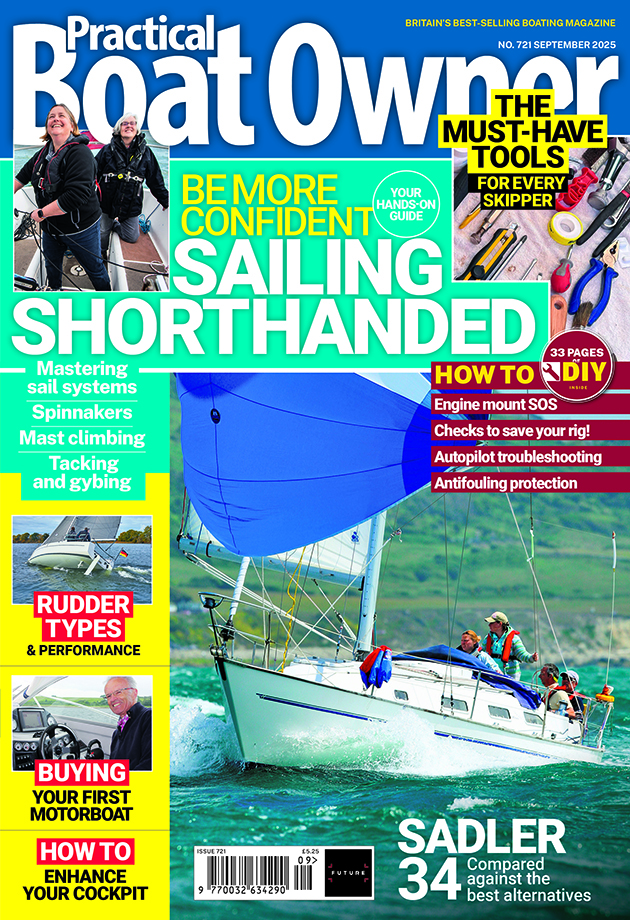
A subscription to Practical Boat Owner magazine costs around 40% less than the cover price.
Print and digital editions are available through Magazines Direct – where you can also find the latest deals.
PBO is packed with information to help you get the most from boat ownership – whether sail or power.
-
-
-
- Take your DIY skills to the next level with trusted advice on boat maintenance and repairs
- Impartial, in-depth gear reviews
- Practical cruising tips for making the most of your time afloat
-
-
Follow us on Facebook, Instagram, TikTok and Twitter

